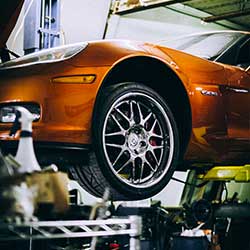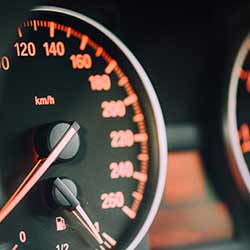Whether you’re a learner, a seasoned driver, or a member of the motor trade who drives new and used cars as part of your job, knowing your stopping distances is a must. Abiding by them will minimise the chances that you’ll cause an accident and invalidate your motor insurance policy in the process.
 Knowing your stopping distances will help you to leave enough space between your vehicle and the one in front of you.
Knowing your stopping distances will help you to leave enough space between your vehicle and the one in front of you.
What Exactly is a Stopping Distance?
Your stopping distance is the distance that your vehicle will travel before coming to a stop when you brake. These distances, which are presented in the UK’s Highway Code, include two elements:
Thinking distance – the distance your car will cover from the moment that you realise that you need to use your brakes until the moment that you apply them.
Breaking distance – the distance your car will travel from the moment that you apply the brakes until the moment that it comes to a complete stop.
Standard Stopping Distances
In general, the stopping distances (your thinking distance plus your breaking distance) for a standard-sized family car are as follows:
- When travelling at 20mph, your stopping distance will be 40 feet/12 metres/approximately three car lengths.
- When travelling at 30mph, your stopping distance will be 75 feet/23 metres/approximately six car lengths.
- When travelling at 40mph, your stopping distance will be 118 feet/36 metres/approximately nine car lengths.
- When travelling at 50mph, your stopping distance will be 174 feet/53 metres/approximately thirteen car lengths.
- When travelling at 60mph, your stopping distance will be 240 feet/73 metres/approximately eighteen car lengths.
- When travelling at 70mph, your stopping distance will be 315 feet/96 metres/approximately twenty-four car lengths.
Motor trade insurance quote
If you are looking for a quote on a motor trade insurance policy, you could save up to 67.5% with Unicom. Click here to get a quote that could save you £££’s
Other Factors You Need to Bear in Mind That Can Affect Your Stopping distances:
- The Road You’re Driving On – If you’re driving on country roads, up or down hills, on badly surfaced roads, or on roads with oil or grease on them, your stopping distances are likely to be longer.
- The Weather Conditions – Your stopping distances will also be longer in adverse weather conditions or when visibility is poor. In fact, the Highway Code states that your vehicle will travel at least twice as far before it stops in wet weather.
- The Type of Vehicle You’re Driving – If you aren’t driving an average-sized family car, your stopping distances may be different. For example, vans or lorries tend to take longer to come to a stop than cars so, if you’re driving one, you’ll need more space.
- Your Vehicle’s Condition – The age and condition of your vehicle will also affect the amount of distance that it will cover before coming to a standstill. If your car has worn brakes or poor-quality tyres, for example, your stopping distances will be longer than those cited.
- Your Reaction Times – If you’re an older driver, tired, or being distracted by your passengers or anything else, your thinking distance, and therefore, your stopping distance, will be greater.
All the above considered, while it’s a licence pass requirement and crucial to learn the standard stopping distances, always use common sense when putting them into practice when out driving, always consider other motorists who may not be as confident at driving.











